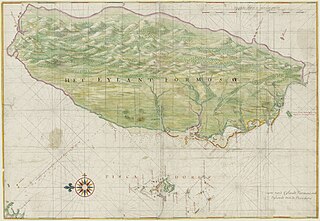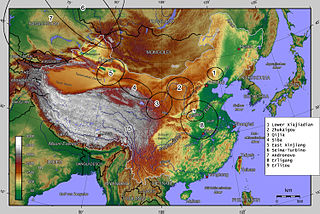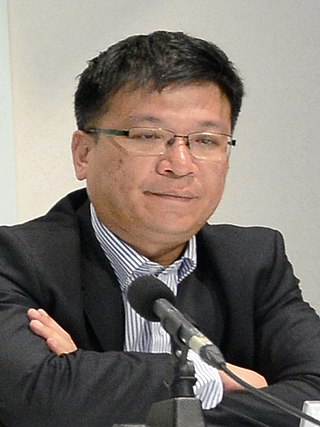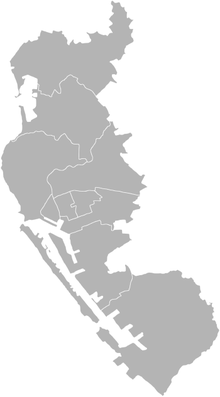
Kaohsiung, officially Kaohsiung City, is a special municipality located in southern Taiwan. It ranges from the coastal urban center to the rural Yushan Range with an area of 2,952 km2 (1,140 sq mi). Kaohsiung City has a population of approximately 2.73 million people as of March 2023 and is Taiwan's third most populous city and largest city in southern Taiwan.

The Penghu or Pescadores Islands are an archipelago of 90 islands and islets in the Taiwan Strait, located approximately 50 km (31 mi) west from the main island of Taiwan across the Pescadores Channel, covering an area of 141 square kilometers (54 sq mi). The archipelago collectively forms Penghu County of Taiwan and is the smallest county of Taiwan. The largest city is Magong, located on the largest island, which is also named Magong.

The Kingdom of Tungning, also known as Tywan by the British at the time, was a dynastic maritime state that ruled part of southwestern Taiwan and the Penghu islands between 1661 and 1683. It is the first predominantly ethnic Han state in Taiwanese history. At its zenith, the kingdom's maritime power dominated varying extents of coastal regions of southeastern China and controlled the major sea lanes across both China Seas, and its vast trade network stretched from Japan to Southeast Asia.

Cimei Township is a rural township in Penghu County, Taiwan. The island is the fifth largest in the Pescadores (Penghu) and the southernmost island in the group. It is the smallest township in Penghu County.

The Port of Kaohsiung is the largest harbor in Taiwan, handling approximately 10.26 million twenty-foot equivalent units (TEU) worth of cargo in 2015. The port is located in southern Taiwan, adjacent to Kaohsiung City, and surrounded by the city districts of Gushan, Yancheng, Lingya, Cianjhen, Siaogang, as well as Cijin. It is operated by Taiwan International Ports Corporation, Taiwan's state-owned harbor management company.

Most information about Taiwan before the arrival of the Dutch East India Company in 1624 comes from archaeological finds throughout the island. The earliest evidence of human habitation dates back 20,000 to 30,000 years, when lower sea levels exposed the Taiwan Strait as a land bridge. Around 5,000 years ago, farmers from the southeast Chinese coast settled on the island. These people are believed to have been speakers of Austronesian languages, which dispersed from Taiwan across the islands of the Pacific and Indian Oceans. The current Taiwanese aborigines are believed to be their descendants.

The cultural history of Taiwan can be traced back to prehistoric Stone Age. Later the development of written languages made it easier to maintain traditions of the Taiwanese culture.

Kaohsiung Main Station is a railway and metro station in Sanmin District, Kaohsiung, Taiwan served by the Taiwan Railways and Kaohsiung Rapid Transit. It is one of four special class stations, the highest class with the most services. It is currently undergoing reconstruction, scheduled to be complete in 2024.

The Tahu Culture was an archaeological culture in southern Taiwan. It distributed around the Tainan-Kaohsiung region. The culture was one of the late Neolithic cultures of Taiwan island. A set of several archaeological sites formed the culture, such as the Tahu Site (大湖遺址), Fengpitou Site (鳳鼻頭遺址) and Wushantou Site (烏山頭遺址). These sites had been excavated out many bone tools, potteries or middens.

The Siwa culture was a Bronze Age culture in southeast Gansu Province, China. It was discovered by Swedish geologist Johan Gunnar Andersson in 1924 at Mount Siwa (寺洼山) in Lintao County, hence its name. It flourished circa 14th to 11th century BC, it is tentatively attributed to the cultures of the Northern Di, Qiang, and Xunyu peoples.
Cao Lin was an imperial prince of the state of Cao Wei in the Three Kingdoms period of China. He was a son of Cao Pi, the first Wei emperor, and the biological father of Cao Mao, the fourth Wei emperor.
Events from the year 2014 in Taiwan, Republic of China. This year is numbered Minguo 103 according to the official Republic of China calendar.

Liang Siyong was a Chinese anthropologist and archaeologist. He was deputy director of the Institute of Archaeology at the Chinese Academy of Sciences. One of the first scholars to introduce the discipline of archaeology to China, Liang is regarded as one of China's "first-generation archaeologists". He was the second son of the scholar Liang Qichao. Liang was married to Li Fuman, with whom he had one daughter. He died of a heart attack on 2 April 1954, at the age of 49.
Fanchengdui culture is an archaeological culture discovered in 1970, in the town of Zhuwei, Qingjiang county, Jiangxi province, China, in archaeological sites such as Fanchengdui. It is a distinctive type of Chalcolithic to Bronze Age culture.
The architecture of Taiwan can be traced back to stilt housing of the aborigines in prehistoric times; to the building of fortresses and churches in the north and south used to colonize and convert the inhabitants during the Dutch and Spanish period; the Tungning period when Taiwan was a base of anti-Qing sentiment and Minnan-style architecture was introduced; in Qing dynasty period, a mix of Chinese and Western architecture appeared and artillery battery flourished during Qing's Self-Strengthening Movement; During the Japanese rule of Taiwan, the Minnan, Japanese and Western culture were main influencers in architectural designs and saw the introduction and use of reinforced concrete. Due to excessive Westernization as a colony, after the retrocession of Taiwan to the Republic of China in 1945 from Japan at the end of World War II, Chinese classical style became popular and entered into international mainstream as a postmodern design style. Today, Taiwanese architecture has undergone much diversification, every style of architecture can be seen.
Lin Daoqian, also written as Lim Toh Khiam and Vintoquián, was a Chinese pirate of Teochew origin active in the 16th century. He led pirate attacks along the coast of Guangdong and Fujian, but they were driven to Taiwan by the Ming dynasty navy commanded by Yu Dayou. He later moved to South East Asia, and settled in Patani where he established a significant presence. He died in Patani.

Hokkien architecture, also called Hoklo architecture or Minnan architecture, refers to the architectural style of the Hoklo people, the Han Chinese group who have historically been the dominant demographic of the Southern Chinese province of Fujian ,and Taiwan, Singapore. This style shares many similarities with those of surrounding Han Chinese groups. There are, however, several features that are unique or mostly unique to Hoklo-made buildings, making many traditional buildings in Hokkien and Taiwan visually distinctive from those outside the region.
Chen Hung-ming is a Taiwanese campus folk singer, songwriter, and member of Little Crow (小烏鴉合唱團) from Penghu. His most famous song is "Forgotten Times" (被遺忘的時光).

Vincent Tseng Wen-sheng is a Taiwanese politician.
















